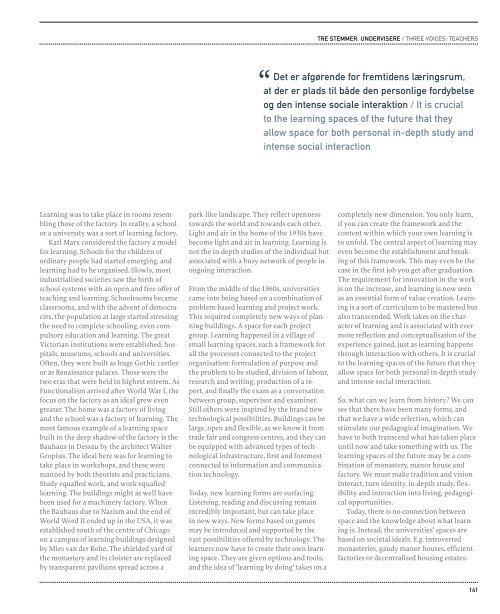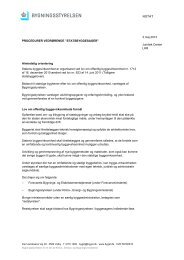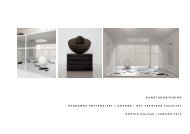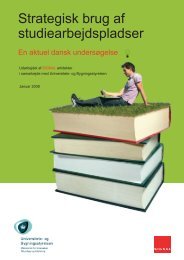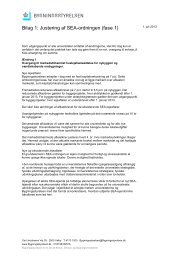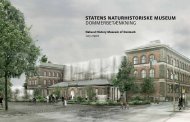Campus og studiemiljø - Bygningsstyrelsen
Campus og studiemiljø - Bygningsstyrelsen
Campus og studiemiljø - Bygningsstyrelsen
Create successful ePaper yourself
Turn your PDF publications into a flip-book with our unique Google optimized e-Paper software.
Learning was to take place in rooms resembling<br />
those of the factory. In reality, a school<br />
or a university was a sort of learning factory.<br />
Karl Marx considered the factory a model<br />
for learning. Schools for the children of<br />
ordinary people had started emerging, and<br />
learning had to be organised. Slowly, most<br />
industrialised societies saw the birth of<br />
school systems with an open and free offer of<br />
teaching and learning. Schoolrooms became<br />
classrooms, and with the advent of democracies,<br />
the population at large started stressing<br />
the need to complete schooling, even compulsory<br />
education and learning. The great<br />
Victorian institutions were established: hospitals,<br />
museums, schools and universities.<br />
Often, they were built as huge Gothic castles<br />
or as Renaissance palaces. Those were the<br />
two eras that were held in highest esteem. As<br />
Functionalism arrived after World War I, the<br />
focus on the factory as an ideal grew even<br />
greater. The home was a factory of living<br />
and the school was a factory of learning. The<br />
most famous example of a learning space<br />
built in the deep shadow of the factory is the<br />
Bauhaus in Dessau by the architect Walter<br />
Gropius. The ideal here was for learning to<br />
take place in workshops, and these were<br />
manned by both theorists and practicians.<br />
Study equalled work, and work equalled<br />
learning. The buildings might as well have<br />
been used for a machinery factory. When<br />
the Bauhaus due to Nazism and the end of<br />
World Word II ended up in the USA, it was<br />
established south of the centre of Chicago<br />
on a campus of learning buildings designed<br />
by Mies van der Rohe. The shielded yard of<br />
the monastery and its cloister are replaced<br />
by transparent pavilions spread across a<br />
park-like landscape. They reflect openness<br />
towards the world and towards each other.<br />
Light and air in the home of the 1930s have<br />
become light and air in learning. Learning is<br />
not the in-depth studies of the individual but<br />
associated with a busy network of people in<br />
ongoing interaction.<br />
From the middle of the 1960s, universities<br />
came into being based on a combination of<br />
problem-based learning and project work.<br />
This required completely new ways of planning<br />
buildings. A space for each project<br />
group. Learning happened in a village of<br />
small learning spaces, each a framework for<br />
all the processes connected to the project<br />
organisation: formulation of purpose and<br />
the problem to be studied, division of labour,<br />
research and writing, production of a report,<br />
and finally the exam as a conversation<br />
between group, supervisor and examiner.<br />
Still others were inspired by the brand new<br />
technol<strong>og</strong>ical possibilities. Buildings can be<br />
large, open and flexible, as we know it from<br />
trade fair and congress centres, and they can<br />
be equipped with advanced types of technol<strong>og</strong>ical<br />
infrastructure, first and foremost<br />
connected to information and communication<br />
technol<strong>og</strong>y.<br />
Today, new learning forms are surfacing.<br />
Listening, reading and discussing remain<br />
incredibly important, but can take place<br />
in new ways. New forms based on games<br />
may be introduced and supported by the<br />
vast possibilities offered by technol<strong>og</strong>y. The<br />
learners now have to create their own learning<br />
space. They are given options and tools,<br />
and the idea of ‘learning by doing’ takes on a<br />
tre stemmer: undervisere / tHree voiCes: teaCHers<br />
“ det er afgørende for fremtidens læringsrum,<br />
at der er plads til både den personlige fordybelse<br />
<strong>og</strong> den intense sociale interaktion / it is crucial<br />
to the learning spaces of the future that they<br />
allow space for both personal in-depth study and<br />
intense social interaction<br />
completely new dimension. You only learn,<br />
if you can create the framework and the<br />
content within which your own learning is<br />
to unfold. The central aspect of learning may<br />
even become the establishment and breaking<br />
of this framework. This may even be the<br />
case in the first job you get after graduation.<br />
The requirement for innovation in the work<br />
is on the increase, and learning is now seen<br />
as an essential form of value-creation. Learning<br />
is a sort of curriculum to be mastered but<br />
also transcended. Work takes on the character<br />
of learning and is associated with ever<br />
more reflection and conceptualisation of the<br />
experience gained, just as learning happens<br />
through interaction with others. It is crucial<br />
to the learning spaces of the future that they<br />
allow space for both personal in-depth study<br />
and intense social interaction.<br />
So, what can we learn from history? We can<br />
see that there have been many forms, and<br />
that we have a wide selection, which can<br />
stimulate our pedag<strong>og</strong>ical imagination. We<br />
have to both transcend what has taken place<br />
until now and take something with us. The<br />
learning spaces of the future may be a combination<br />
of monastery, manor house and<br />
factory. We must make tradition and vision<br />
interact, turn identity, in-depth study, flexibility<br />
and interaction into living, pedag<strong>og</strong>ical<br />
opportunities.<br />
Today, there is no connection between<br />
space and the knowledge about what learning<br />
is. Instead, the universities’ spaces are<br />
based on societal ideals. E.g. introverted<br />
monasteries, gaudy manor houses, efficient<br />
factories or decentralised housing estates.<br />
141


